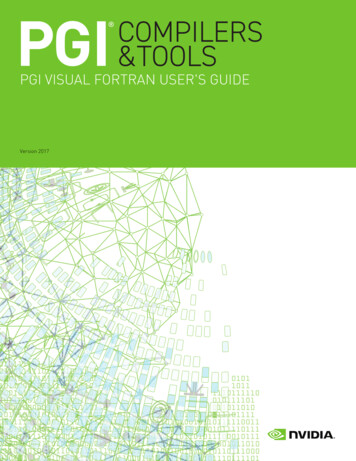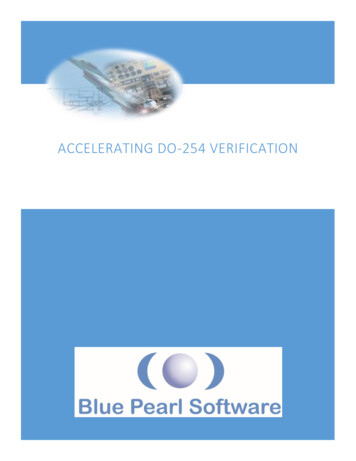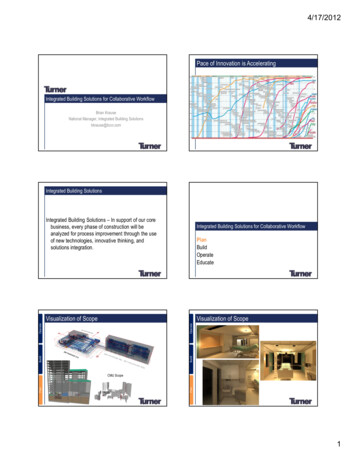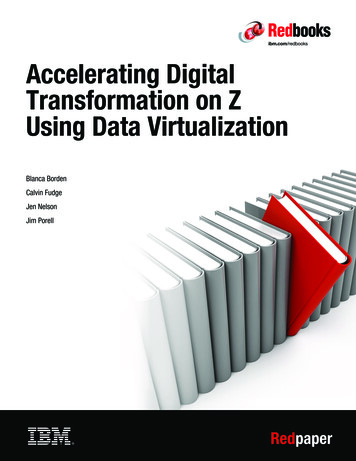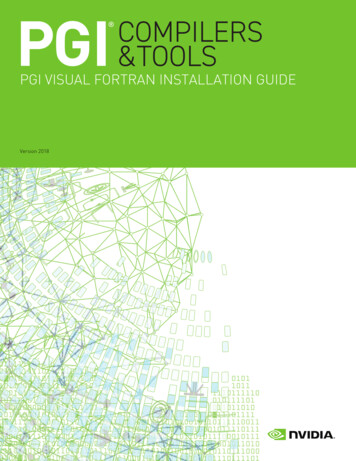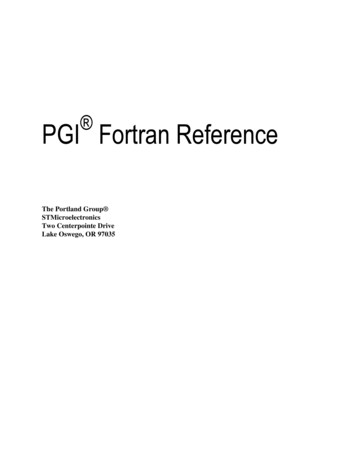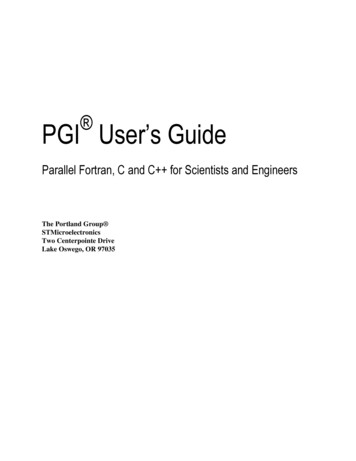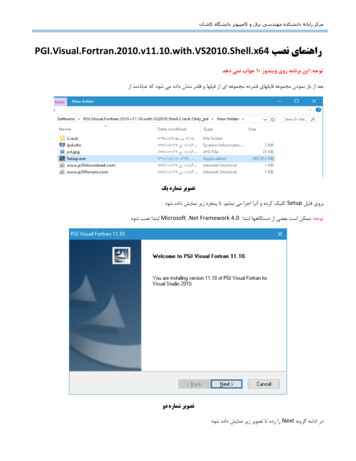
Transcription
Accelerating weathermodels with PGI compilersThe Portland Groupwww.pgroup.comdave.norton@pgroup.com
CUDA Fortran in 3 slides
CUDA Fortran VADD Host Codesubroutine vadd( A, B, C )use cudaforuse kmodreal, dimension(:) :: A, Breal, pinned, dimension(:) :: Creal, device, allocatable:: Ad(:), Bd(:), Cd(:)integer :: NN size( A, 1 )allocate( Ad(N), Bd(N), Cd(N) )Ad A(1:N)Bd B(1:N)call vaddkernel (N 31)/32,32 ( Ad, Bd, Cd, N )C Cddeallocate( Ad, Bd, Cd )end subroutine3
CUDA Fortran VADD Device Codemodule kmoduse cudaforcontainsattributes(global) subroutine vaddkernel(A,B,C,N)real, device :: A(N), B(N), C(N)integer, value :: Ninteger :: ii (blockidx%x-1)*32 threadidx%xif( i N ) C(i) A(i) B(I)end subroutineend module4
Building a CUDA Fortran Program CUDA Fortran is supported by the PGI Fortran compilers when the filenameuses a CUDA Fortran extension. The .cuf extension specifies that the file is afree-format CUDA Fortran program; The .CUF extension may also be used, in which case the program isprocessed by the preprocessor before being compiled. To compile a fixed-format program, add the command line option –Mfixed. CUDA Fortran extensions can be enabled in any Fortran source file byadding the –Mcuda command line option. Most F2003 features should work in CUDA Fortran. There is a (CUDA-like) API to access features Streams supported through API rather then language
Accelerator Directives for flatperformance profile codesin 6 slides
Accelerator VADD Device Code(two dimensional array example)module kmodcontainssubroutine vaddkernel(A,B,C)real :: A(:,:), B(:,:), C(:,:)! acc regionC(:,:) A(:,:) B (:,:) lots of other code to do neat stuff special code to do even neater stuff ! acc end regionend subroutineend module! acc region clauses can surround many individualloops and compute kernels. There is no implicitGPU/CPU data movement within a region7
Compiling the subroutine:PGI pgfortran -Minfo accel -ta nvidia -c vadd.F90vaddkernel:5, Generating copyout(c(1:z b 14,1:z b 17))Generating copyin(a(1:z b 14,1:z b 17))Generating copyin(b(1:z b 14,1:z b 17))Generating compute capability 1.0 binaryGenerating compute capability 1.3 binaryGenerating compute capability 2.0 binary6, Loop is parallelizableAccelerator kernel generated6, ! acc do parallel, vector(16) ! blockidx%x threadidx%x! acc do parallel, vector(16) ! blockidx%y threadidx%yCC 1.0 : 7 registers; 64 shared, 8 constant, 0 local memory bytes; 100% occupancyCC 1.3 : 8 registers; 64 shared, 8 constant, 0 local memory bytes; 100% occupancyCC 2.0 : 15 registers; 8 shared, 72 constant, 0 local memory bytes; 100% occupancy
Tuning the compute kernelAccelerator VADD Device Codemodule kmodcontainssubroutine vaddkernel(A,B,C)! We know array sizereal :: A(:,:), B(:,:), C(:,:)! dimension(2560,96)integer :: i,j! acc region! acc do paralleldo j 1,size(A,1)! acc do vector(96)do i 1,size(A,2)C(j,i) A(j,i) B (j,i)enddoenddo! acc end regionend subroutineend module9
Keeping the data on the GPUAccelerator VADD Device Codemodule kmodcontainssubroutine vaddkernel(A,B,C)real :: A(:,:), B(:,:), C(:,:)! acc reflected (A,B,C)! acc regionC(:,:) A(:,:) B (:,:)! acc end regionend subroutineend moduleThe ! reflected clause must be visible to thecaller so it knows to pass pointers to arrays onthe GPU rather then copyin actual array data.10
Compiling the subroutine:PGI pgfortran -Minfo accel -ta nvidia -c vadd.F90vaddkernel:5, Generating reflected(c(:,:))Generating reflected(b(:,:))Generating reflected(a(:,:))6, Generating compute capability 1.0 binaryGenerating compute capability 1.3 binaryGenerating compute capability 2.0 binary7, Loop is parallelizableAccelerator kernel generated7, ! acc do parallel, vector(16) ! blockidx%x threadidx%x! acc do parallel, vector(16) ! blockidx%y threadidx%yCC 1.0 : 11 registers; 80 shared, 8 constant, 0 local memory bytes; 66% occupancyCC 1.3 : 11 registers; 80 shared, 8 constant, 0 local memory bytes; 100% occupancyCC 2.0 : 17 registers; 8 shared, 88 constant, 0 local memory bytes; 100% occupancy
Allocating/Deallocating GPU ArraysAccelerator VADD Device Codesubroutine vadd(M,N,C)use kmod ! Visibility of ! acc reflectedreal, dimension(:,:) :: A, B, Cinteger :: N! acc mirror(A,B) !device resident clause in 1.3allocate(A(M,N),B(M,N))! C has been mirrored and allocated previouslyA 1.0B 2.0! acc update device(A,B,C)call vaddkernel (A,B,C)call kernel2 (A,B,C)call kernel3 (A,B,C)call kernel4 (A,B,C)! acc update host(C)deallocate( A, B)end subroutine12
Using GPU device-resident dataacross subroutinessubroutine timestep(Input,Result,M,N)use kmod ! Make reflected var’s visiblereal, dimension(M,N) :: Input,Result! acc reflected (Input,Result)integer :: M,Nreal, allocatable :: B,C,Ddimension(:,:) :: B,C,D! acc mirror(B,C,D)allocate(B(M,N),C(M,N),D(M,N))B 2.0! acc update device(Input,B)call vaddkernel (Input,B,C).call kernel2 (C,D).call kernel3 (D,Result)! acc update host(Result)deallocate(B,C,D)end subroutineCPU Codemodule kmodContains!subroutine vaddkernel(A,B,C)real :: A(:,:),B(:,:),C(:,:)! acc reflected (A,B,C)! acc regionC(:,:) A(:,:) B (:,:)! acc end regionend subroutine!subroutine kernel2(C,D)real :: C(:,:),D(:,:)! acc reflected (C,D)! acc region compute-intensive loops ! acc end regionend subroutine.end moduleGPU Code
% pgfortran -help -ta-ta nvidia:{analysis nofma [no]flushz keepbin keepptx keepgpu maxregcount: n c10 cc11 cc12 cc13 cc20 fastmath mul24 time cuda2.3 cuda3.0 cuda3.1 cuda3.2 cuda4.0 [no]wait} hostChoose target acceleratornvidiaSelect NVIDIA accelerator targetanalysisAnalysis only, no code generationnofmaDon't generate fused mul-add instructions[no]flushzEnable flush-to-zero mode on the GPUkeepbinKeep kernel .bin fileskeepptxKeep kernel .ptx fileskeepgpuKeep kernel source filesmaxregcount: n Set maximum number of registers to use on the GPUcc10Compile for compute capability 1.0.cc20Compile for compute capability 2.0fastmathUse fast math librarymul24Use 24-bit multiplication for subscriptingtimeCollect simple timing informationcuda2.3Use CUDA 2.3 Toolkit compatibility.cuda4.0Use CUDA 4.0 Toolkit compatibility[no]waitWait for each kernel to finish; overrides nowait clausehostCompile for the host, i.e. no accelerator target
Compute region directive clauses for tuningdata allocation and movementClauseMeaningif (condition)Execute on GPU conditionallycopy (list)Copy in and out of GPU memorycopyin (list)Only copy in to GPU memorycopyout (list)Only copy out of GPU memorylocal (list)Allocate locally on GPUdeviceptr (list)C pointers in list are device pointersupdate device (list) Update device copies of the arraysupdate host (list)Update host copies of the arrays
Loop directive clauses for tuningGPU kernel schedulesClauseMeaningparallel [(width)]Parallelize the loop across the multiprocessorsvector [(width)]SIMD vectorize the loop within a multiprocessorseq [(width)]Execute the loop sequentially on eachthread processorindependentIterations of this loop are data independentof each otherunroll (factor)Unroll the loop factor timescache (list)Try to place these variables in sharedmemoryprivate (list)Allocate a copy of each variable in list foreach loop iteration
Timing / Profiling How long does my program take to run? time ./myprogram How long do my kernels take to run? pgfortran –ta nvidia,time Environment variables: export ACC NOTIFY 1 export NVDEBUG 1 # cuda profiler settings #export CUDA PROFILE 1 #export CUDA PROFILE CONFIG cudaprof.cfg #export CUDA PROFILE CSV 1 #export CUDA PROFILE LOG cudaprof.log
Compiler-to-Programmer FeedbackIncremental porting/tuning for GPUsDirectives, Options, estructuring forAccelerators willbe More Difficultthan vectorizationPerformancex64 AccTracePGPROF
Obstacles to GPU code generation Loop nests to be offloaded to the GPU must be rectangular At least some of the loops to be offloaded must be fully data parallel withno synchronization or dependences across iterations Computed array indices should be avoided All function calls must be inlined within loops to be offloaded In Fortran, the pointer attribute is not supported; pointer arrays may bespecified, but pointer association is not preserved in GPU device memory In C Loops that operate on structs can be offloaded, but those that operate on nestedstructs cannot Pointers used to access arrays in loops to be offloaded must be declared with C99restrict (or compiled w/-Msafeptr, but it is file scope) Pointer arithmetic is not allowed within loops to be offloaded
Evolution of the Directives Published Version 1.0 of the PGI AcceleratorDirectives Intent of publication was to start discussion onstandardization process Implemented v1.o Standardization process started throughOMP Published Version 1.3 of the PGI AcceleratorDirectives Currently implementing v1.3
C99, C , F2003 Compilers Optimizing Vectorizing Parallelizing Graphical parallel tools PGDBG debugger PGPROF profiler AMD, Intel, NVIDIA, ST 64-bit / 32-bit PGI Unified Binary Linux, MacOS, Windows Visual Studio integration GPGPU Features CUDA Fortran PGI Accelerator CUDA-x86www.pgroup.com
Reference Materials PGI Accelerator programming model http://www.pgroup.com/lit/whitepapers/pgi accel prog model 1.3.pdf CUDA Fortran .pdf CUDA-x86 http://www.pgroup.com/resources/cuda-x86.htm Understanding the CUDA Threading Model htm
CUDA Fortran is supported by the PGI Fortran compilers when the filename uses a CUDA Fortran extension. The .cuf extension specifies that the file is a free-format CUDA Fortran program; The .CUF extension may also be used, in which case the program is processed by the preprocessor before being compiled. To compile a fixed-format program, add the command line option –Mfixed. CUDA Fortran .
